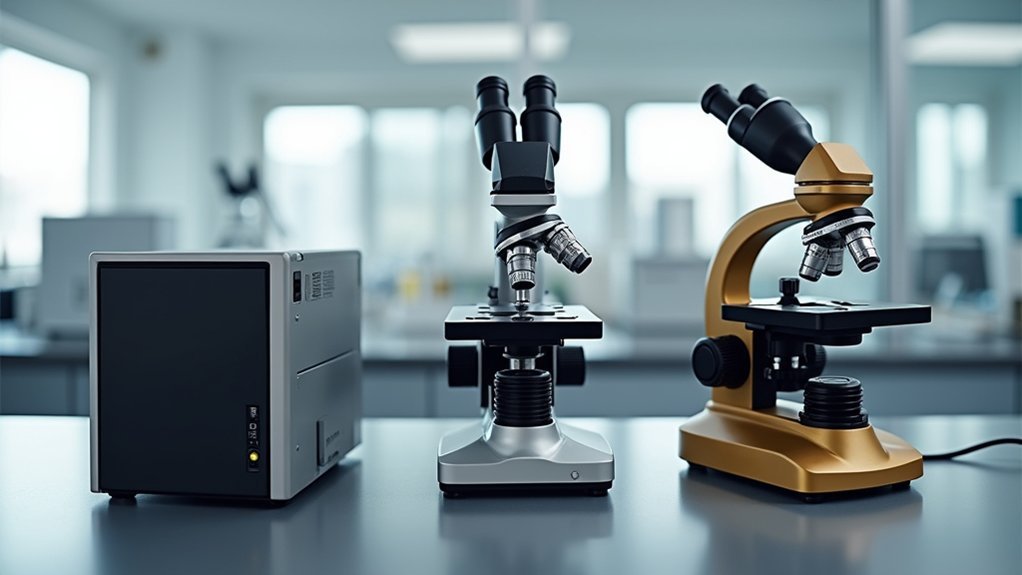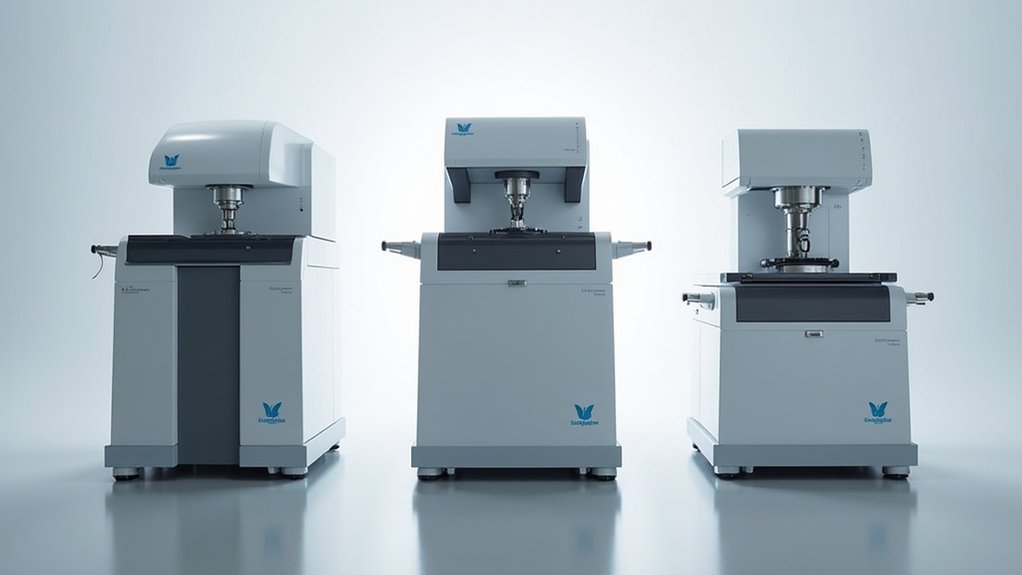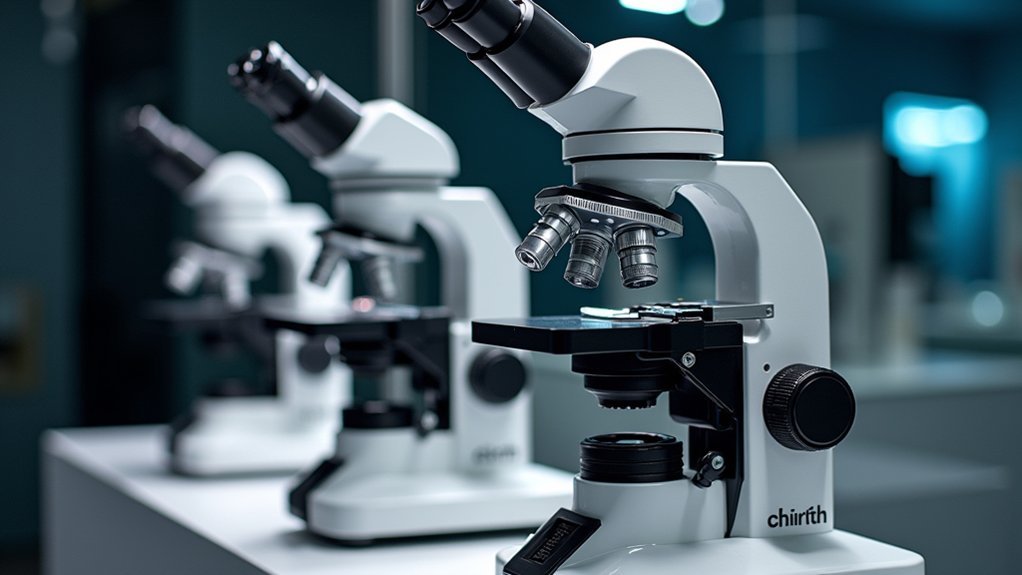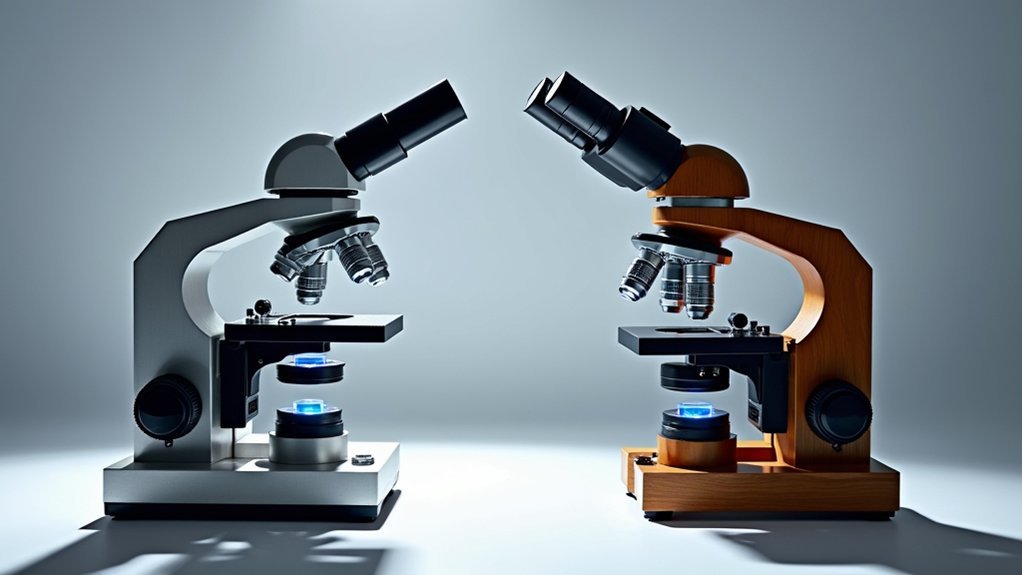Phase contrast microscope systems range from entry-level models ($8,000-$15,000) to premium options (over $50,000). Budget systems work well for basic observation and teaching labs, while mid-range options like Olympus IX3 and Nikon Eclipse Ti2 offer enhanced clarity for research. Premium systems from Zeiss, Nikon, Leica, and Olympus feature advanced automation and superior optics for cutting-edge applications. Your choice should depend on your specific research needs and available budget. Discover which specifications truly matter for your laboratory’s unique requirements.
Understanding the Price Range of Phase Contrast Microscope Systems

When evaluating phase contrast microscopy options, you’ll encounter a broad spectrum of pricing that reflects varying capabilities and target applications.
Entry-level models suitable for undergraduate teaching labs typically range from $8,000 to $15,000, providing fundamental capabilities without advanced features.
Entry-level phase contrast microscopes deliver essential functionality for teaching environments while maintaining reasonable cost parameters.
For specialized research, premium phase contrast microscope systems can exceed $50,000, offering superior performance and sophisticated functionality.
Many manufacturers offer modular systems where you can start with a base model and add components as needed, though this can increase costs by 30-40%.
Budget-conscious laboratories generally seek systems under $500,000, with many choosing brands like Leica or Thorlabs for their balance of affordability and functionality.
Newer subscription models for software features ($2,000-$5,000 annually) offer flexibility to scale capabilities based on your changing needs.
Entry-Level Phase Contrast Solutions: Features and Limitations
Although designed for accessibility, entry-level phase contrast systems offer substantial value for basic microscopy needs while presenting distinct limitations. Priced between $8,000-$15,000, these microscopes provide fundamental capabilities for observing biological samples without staining, making them ideal for educational purposes and routine lab work.
You’ll find these systems equipped with essential contrast methods that allow visualization of living specimens, though image clarity won’t match premium alternatives. While adequate for standard high magnification work, entry-level models typically lack advanced automation, sophisticated software integration, and the optical refinements of higher-end equipment.
For undergraduate teaching labs and smaller research facilities, these systems represent a practical starting point, though you may need to budget for future accessories if your research needs expand beyond basic applications.
Mid-Range Options: Balancing Cost and Performance

Despite sharing a similar price range with entry-level models, mid-range phase contrast systems deliver greatly enhanced performance capabilities that justify their position in the market. Priced between $8,000 and $15,000, these systems offer accessibility for undergraduate labs while providing features essential for serious life science research.
Mid-range phase contrast microscopes deliver research-grade capabilities without premium pricing, serving both educational and professional applications effectively.
You’ll find the Olympus IX3 series delivers enhanced image clarity through patented optical coatings, making it ideal for live-cell imaging.
Nikon’s Eclipse Ti2 counters with its Perfect Focus System that minimizes drift during dynamic observations. For budget-conscious labs, Leica Microsystems offers affordable specialized configurations that don’t compromise on quality.
What sets these mid-range options apart is their technological integration—Nikon’s machine learning algorithms automate cell counting and morphology assessments, greatly improving research efficiency without premium pricing.
Premium Phase Contrast Systems: Advanced Capabilities Worth the Investment
Many researchers wonder if premium phase contrast systems justify their steep price tags—they absolutely do. These sophisticated instruments from Olympus, Zeiss, Nikon, and Leica incorporate advanced optical technologies that dramatically enhance your research capabilities.
| Brand | Key Feature | Best Application |
|---|---|---|
| Nikon Eclipse Ti2 | Perfect Focus System | Live-cell imaging |
| Leica Thunder | Computational clearing | Thick tissue analysis |
| Olympus/Zeiss | Seamless mode switching | Multi-modal research |
Premium systems ($50,000+) deliver superior performance through proprietary optical coatings and large field-of-view designs. You’ll benefit from integrated machine learning algorithms that automate cell counting and morphology assessments, dramatically increasing lab efficiency. For institutions pushing scientific boundaries, these systems aren’t merely equipment—they’re essential research partners that eliminate technical limitations.
Key Specifications That Impact Pricing in Phase Contrast Microscopy

When evaluating phase contrast microscopes, understanding the specifications that drive pricing helps you make informed investment decisions.
The quality of optical lenses greatly affects cost, with premium phase contrast systems featuring superior optics that deliver enhanced image clarity and high contrast visualization—commanding prices up to $50,000.
Modular designs offer customization options that influence price points, allowing you to select configurations that match your specific requirements.
Advanced features like automated focusing systems and integrated image analysis software contribute considerably to higher costs but provide improved workflow efficiency.
Your investment consideration should balance the precision required for your applications against available budget.
Entry-level systems starting at $8,000 may suffice for basic needs, while specialized biomedical research might justify investing in premium models with superior imaging capabilities.
Making the Right Purchase Decision: Matching Systems to Application Requirements
Selecting the ideal phase contrast system requires a careful assessment of your specific research or diagnostic needs before committing to a purchase. Your budget will greatly impact options, from $8,000 entry-level models for undergraduate labs to specialized systems exceeding $50,000 for advanced research environments.
- Application requirements dictate system features – biomedical researchers need live-cell imaging capabilities, while academic settings benefit from modular systems offering customization options.
- Regulatory compliance matters for clinical applications – remember phase contrast systems are Class II medical devices requiring FDA compliance.
- Regional availability affects your choices – consider local market access to both equipment and technical support when selecting systems.
Don’t overlook industry-specific needs – biomedical applications prioritize different features than material sciences focused on polymer research and nanotechnology.
Frequently Asked Questions
Is Phase Contrast Worth It?
Yes, phase contrast is worth it if you’re studying live cells. You’ll see incredible detail without staining specimens. Despite the high investment ($8,000-$15,000), the technology delivers unique value for cellular research applications.
What Type of Microscope Is More Expensive?
Electron microscopes are considerably more expensive than phase contrast systems. You’ll pay $100,000 to millions for electron microscopes, while high-end phase contrast microscopes typically max out around $50,000-60,000 for fully equipped research models.
What Are the Disadvantages of Phase Contrast Microscope?
You’ll face halo effects that obscure details, potential misalignment issues, high costs ($8,000-$15,000), required specialized training, and complicated maintenance with phase contrast microscopes. They’re also challenging to calibrate for ideal results.
How Much Should I Pay for a Microscope?
You’ll pay $8,000-$15,000 for entry-level microscopes, $15,000-$30,000 for mid-range options, or $50,000+ for premium models. Consider your specific needs and budget for additional features or subscription software costs when choosing.
In Summary
You’ll find phase contrast microscopy systems across every price point, from basic educational models to research-grade instruments. Consider your specific application needs before investing—budget options work well for routine observations, while premium systems deliver superior contrast and resolution for demanding applications. Remember that optical quality, mechanical stability, and illumination systems are the key factors that determine both performance and price.





Leave a Reply